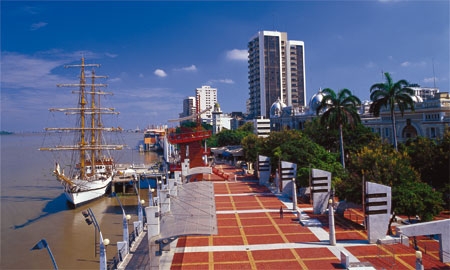The port is now a thoroughly modern metropolis which boasts numerous museums, historic neighbourhoods, sprawling parks, and a beautifully renovated waterfront strip – the city´s piece de resistance. The Malecón 2000 – a promenade running two miles along the Guayas river – is part of Guayaquil´s urban reform scheme initiated eleven years ago by the Leon Febres-Cordero administration; current mayor Jaime Nebot continued the work and has brought the project to a successful conclusion.
Although the scheme began with the restoration and renovation of the waterfront, initially aimed at attracting foreign investment, the work has also resulted in the upgrading of various informal and marginalized community facilities.
For example, the Malecón 2000 resulted in the upgrading of Las Peñas by the simple action of painting the facades of houses. When Las Peñas regained its identity and the attention of the city, residents established informal businesses in the corners of their homes. Small cafes, bars, cigarette shops sprung up on a regular basis after the townsfolk were given the opportunity to participate in a series of workshops on starting a business and how best to treat tourists. Another example of a positive knock-on effect was project Viernes Santo, a small sports and water park which consists of a swimming pool with fountains and playground. Other amenities include a bike lane, some basketball and soccer courts, bathrooms, food kiosks and a trail that borders the entire perimeter.
These examples show how Guayaquil is a prime example of efficacious governance and how urban regeneration can help bring a region’s potential, for both business and tourism, to the fore.
| “THERE HAS BEEN A GREAT URBAN REGENERATION. THERE ARE UNIQUE PLACES LIKE THE GUAYAS RIVERSIDE, THE SANTA ANA HILL, THE ESTERO SALADO WATERFRONT, PLUS MUSEUMS, CHURCHES, PARKS, A MAGNIFICENT HOSTELRY INDUSTRY, EXCELLENT FOOD, HOTELS, CASINOS AND NIGHTCLUBS ALL MAKE GUAYAQUIL A CITY WORTH VISITING.” |
Lauded internationally for his efforts, Mayor Nebot is a popular and formidable figure in Ecuadorian politics. His signature policies as mayor have improved both the city’s physical appearance and its economy, earning him a reputation as an urban innovator. “There has been a great urban regeneration. There are unique places like the Guayas riverside, the Santa Ana hill, the Estero Salado waterfront, plus museums, churches, parks, a magnificent hostelry industry, excellent food, hotels, casinos and nightclubs all make Guayaquil a city worth visiting,” he said.
Today, there’s a feeling of a new and proud identity in the air for Guayacos that is almost tangible as you walk through a city whose physical and social metamorphosis has made it a welcoming destination for natives and visitors alike. And exciting things lie ahead for Guayaquil, as the government has initiated schemes to improve air quality and alleviate traffic congestion, which has been helped with the introduction of Metrovia in 2006.
This rapid public transport system, for which Mayor Nebot was awarded the Sustainable Transport Award in Washington DC in 2007, is comprised of an elevated transit lane for buses along seven core routes, and is considered one of the most modern systems of its kind in Latin America. In a city where traffic jams used to mean inevitable delays, Metrovia’s usefulness is invaluable, as it can whisk passengers from the north of the city to the south in a mere 15 minutes, or to the airport with plenty of time left for last-minute shopping and a relaxing cup of coffee.
Meanwhile, Guayaquil’s recently built Terrestrial Terminal at the Jaime Roldos Aguilera Station has marked another milestone in the city’s development. This bus terminal affords convenient transport links in addition to modern facilities, including a cinema, a medical centre and a supermarket. More than 80 bus companies currently operate services from here, and once the terminal is finished, it will see an estimated 50 million passengers per year pass through.

0 COMMENTS